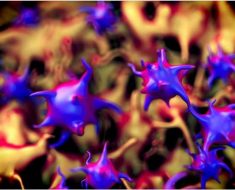During normal pregnancy, mothers always gain body weight within a proper range. However, many women worry that extra pounds put on during pregnancy will not be lost after childbirth and, in fact, past studies have shown that excessive gestational weight gain is associated with immediate postpartum weight retention. But in a new study using a mouse model, researchers at University of California San Diego School of Medicine suggest that long-term postpartum weight gain may be due not so much to retained fat as to reprogramming of maternal energy metabolism.
Writing in the January 8 online issue of the International Journal of Obesity, a team of researchers led by senior author Jianhua Shao, MD, PhD, professor in the Department of Pediatrics at UC San Diego School of Medicine, found that pregnant mice fed a high-fat (HF) diet gained significantly more body fat compared to control mice, but quickly lost the added weight after giving birth.
However, even with a normal diet three months after parturition or giving birth, pregnant mice that received a HF diet during pregnancy began gaining more fat again and nine months after delivery weighed two-fold above levels of control mice due to excess fat mass. Notably, the scientists said the metabolism of mice who were fed a HF diet during pregnancy had slowed, measurably reducing their energy expenditure and thus contributing to fatty weight gain.
“Excessive gestational weight gain increases the risk of long-term postpartum obesity,” said Shao, “and our study showed that pregnant mice consuming a high fat diet significantly increased white fat cell gain, which is characteristic in humans too.
“But these mice lost that weight gain soon after giving birth, only to become spontaneously obese a few months later. The data demonstrate that excessive gestational weight gain-induced postpartum obesity is not simply an extension of pregnancy-induced fat gain or fat retention, but rather a fundamental change in maternal metabolism that results in less energy expended and more weight added as the result.”
Specifically, Shao and colleagues found that while levels of blood estrogen in mice fed HF during pregnancy and three groups of control mice were similar after giving birth, there was a significant decrease in estrogen signaling in both white and brown adipose tissues in the HF fed group. Their study suggests that the reduction of estrogen signaling gradually develops after pregnancy and giving birth due to the slow adipocyte renewal process. Given that estrogen plays an important role in fat development and energy metabolism, the impairment of estrogen signaling within fat may provide a mechanism for excessive weight gain-induced, long-term postpartum obesity.
The authors underscored that their findings are based on studies of mice and will need to be verified in humans. But if they are, said Shao, it “will lead us to define a new cause of obesity in women after pregnancy and will reveal a new vulnerable window for reprogramming of energy metabolism during adult life.”
The authors said their findings, if confirmed in humans, could provide an explanation for how women have overtaken men in the obesity epidemic. After similar rising rates of obesity for more than a decade, a 2015 report by the Centers for Disease Control and Prevention found that women had surpassed men in terms of obesity, with 38 percent of adult women in the United States deemed obese compared to 34 percent of men. More recent statistics place those percentages even higher at 41 and 38, respectively. Clinical data have demonstrated that obesity has significant health risks to the mother in later life, including cardiovascular disease and diabetes.
Source: Read Full Article





